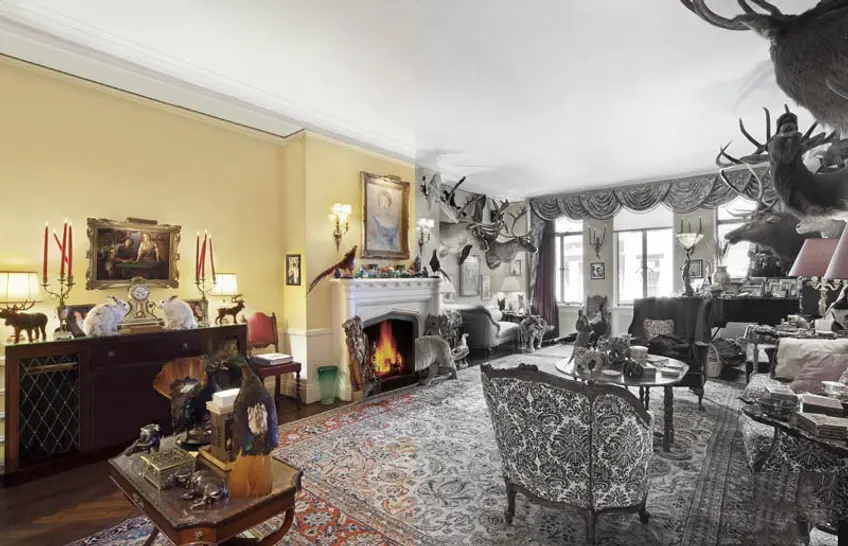 Before and after a virtual renovation of an apartment in The Beresford (Halstead0
Before and after a virtual renovation of an apartment in The Beresford (Halstead0
Is buying a home like online dating? Jason Saft, a real estate agent at Compass, thinks so. “Looking for real estate is a lot like being on Tinder. You see a hundred listings, you swipe right if you like it or swipe left if you don’t. If an apartment looks bad, people will pass it up.”
In order to make a listing more worthy of “swiping right,” Saft is a firm believer in what he calls “the art of real estate,” a process that involves staging—furnishing the home temporarily to make it seem more alluring. While physical staging has been around for some time, virtual staging, or altering listing photos to show furnishings and other aesthetic choices not actually in the unit, have been gaining popularity recently.
At times, Saft even advocates both types of staging. “Looks matter: when you create a plan to showcase a home, a real estate agent must factor in who the client is, what style draws them in and will engage them to want to view your listing,” he says.
In order to make a listing more worthy of “swiping right,” Saft is a firm believer in what he calls “the art of real estate,” a process that involves staging—furnishing the home temporarily to make it seem more alluring. While physical staging has been around for some time, virtual staging, or altering listing photos to show furnishings and other aesthetic choices not actually in the unit, have been gaining popularity recently.
At times, Saft even advocates both types of staging. “Looks matter: when you create a plan to showcase a home, a real estate agent must factor in who the client is, what style draws them in and will engage them to want to view your listing,” he says.
In this article:
With the growing popularity of virtual walkthroughs and the decreased cost of the virtual experience, like with Facebook’s Oculus Rift on pre-order for $599 and the practically free Google Cardboard, buyers can now see virtual tours of entire properties—sometimes, ones that do not even exist yet.
Some have called virtual renovations “digital trickery.” But they are legal. And, if transparently done, they comply with the Article 12 of the Realtor Code of Ethics requires that agents, "be honest and truthful in their real estate communications and… present a true picture in their advertising, marketing, and other representations." (Luiz Ortiz, the Manhattan real estate broker featured on the reality show Million Dollar Listing New York, digitally enhanced promotional photos of a $7 million home on air!)
Below is an example of two listing photos, the first is the existing kitchen, the second is the virtual renovation of the kitchen with the words “virtually staged” in the bottom left of the photograph.
Some have called virtual renovations “digital trickery.” But they are legal. And, if transparently done, they comply with the Article 12 of the Realtor Code of Ethics requires that agents, "be honest and truthful in their real estate communications and… present a true picture in their advertising, marketing, and other representations." (Luiz Ortiz, the Manhattan real estate broker featured on the reality show Million Dollar Listing New York, digitally enhanced promotional photos of a $7 million home on air!)
Below is an example of two listing photos, the first is the existing kitchen, the second is the virtual renovation of the kitchen with the words “virtually staged” in the bottom left of the photograph.
"Snapping camera phone pictures to list an apartment is not acceptable anymore. It’s a disservice to the art of real estate."
Saft believes, “Snapping camera phone pictures to list an apartment is not acceptable anymore. It’s a disservice to the art of real estate. I understand why many owners and developers feel they can do it on their own based on previous experience with real estate agents who take the easy way but that ultimately leads to increased vacancy and price decreases.”
Below is one of Saft’s listings. It was on the market for over three months with two different brokers at two different firms before the frustrated sellers brought the listing to Saft. He virtually staged the photo below which is juxtaposed against a photo from a previous listing. After only two weeks on the market with Saft, the unit had two offers.
Below is one of Saft’s listings. It was on the market for over three months with two different brokers at two different firms before the frustrated sellers brought the listing to Saft. He virtually staged the photo below which is juxtaposed against a photo from a previous listing. After only two weeks on the market with Saft, the unit had two offers.
Saft is adamant that, “virtual renovations must be done with honesty and integrity.” He explains that if an agent presents virtual renovations of what a space could be, they must work with experts to make sure what they are presenting is actually doable. It is false advertising if you misrepresent how beautiful a space can be. If you do not work with an architect and engineer and make sure that the wall you remove isn’t load bearing, for example, then it can be very dangerous.”
Mark Gothelf is the CEO of Virtual Renovations, a firm offering these mock-ups to Realtors. “I would never go ahead without an architect or engineer involved to see if the proposed changes would work. But in some cases, it’s really obvious if it’s not a load bearing wall, like an interior closest,” he says.
Gothelf describes his typical clients as having “more unusual properties which are either great spaces that are really run down or two spaces they want to combine into one.”
Gothelf describes the design process as a multistep back and forth between his company and the broker or architect, increasing in detail (and cost) as they progress.The middle stage, where the client decides on the level of detail, e.g. what kind of furnishings, moving or adding walls or windows, colors and finishes, that determines the final price.
The photo below shows Virtual Renovation’s addition of a windowed wall to create a separation of space to a studio while still allowing a view of the Empire State building (yes, that’s the real view!) from the entire apartment.
Mark Gothelf is the CEO of Virtual Renovations, a firm offering these mock-ups to Realtors. “I would never go ahead without an architect or engineer involved to see if the proposed changes would work. But in some cases, it’s really obvious if it’s not a load bearing wall, like an interior closest,” he says.
Gothelf describes his typical clients as having “more unusual properties which are either great spaces that are really run down or two spaces they want to combine into one.”
Gothelf describes the design process as a multistep back and forth between his company and the broker or architect, increasing in detail (and cost) as they progress.The middle stage, where the client decides on the level of detail, e.g. what kind of furnishings, moving or adding walls or windows, colors and finishes, that determines the final price.
The photo below shows Virtual Renovation’s addition of a windowed wall to create a separation of space to a studio while still allowing a view of the Empire State building (yes, that’s the real view!) from the entire apartment.
"... never go ahead without an architect or engineer involved to see if the proposed changes would work."
There are varying degrees of virtual renovations, from staging to full blown renderings of what could be. Another company offering these outsourced services to Realtors, Gotham Photo Company, sells three virtual renovation packages: envision, renew and revamp.
“Envision” furnishes an empty space, any style you want (i.e. classic, modern). “Renew” cleans up a messy space, removing clutter and dirt. And the “revamp” package makes “minor to moderate renovations” like changing floors, kitchen cabinets and adding or removing walls. Gotham’s cost ranges from $80-$185 per image.
“Envision” furnishes an empty space, any style you want (i.e. classic, modern). “Renew” cleans up a messy space, removing clutter and dirt. And the “revamp” package makes “minor to moderate renovations” like changing floors, kitchen cabinets and adding or removing walls. Gotham’s cost ranges from $80-$185 per image.
According to a recent New York Times article, physical staging costs have almost doubled in the past 10 years (from $5,000 to $10,000). That is significantly more than the virtual possibilities. Real estate agents, like Jason Saft, absorb the cost virtual staging and renovation themselves, citing the adage, “you’ve got to spend money to make money.”
Alison Draper, an agent at Halstead Property, highlights some dangers of virtual staging. The first is the extra time it takes to browse ever more listing photos. “Flipping through more photos online takes time. If I have to see original and staged photos, it takes up more time.”
The second danger Draper points out is the possibility of disappointment when a potential buyer sees the actual of the physical space. With physical staging, the buyer has more of a feel when they are actually in the space and there is no disjunction between the photos and the actual space prospective buyers see on a walkthrough.
Draper says she considers virtual staging only in lieu of physical staging. Often the choice between virtual and physical staging comes down to cost. Draper feels, “virtual staging is definitely better than nothing. If you have an empty apartment, it can be very hard to visualize what that space can be. Virtual staging easily communicates things like what size couch can fit in a space and how many people can sit at a dining table.” At a fraction of the cost, virtual staging can give the missing perspective needed to an empty box.
Alison Draper, an agent at Halstead Property, highlights some dangers of virtual staging. The first is the extra time it takes to browse ever more listing photos. “Flipping through more photos online takes time. If I have to see original and staged photos, it takes up more time.”
The second danger Draper points out is the possibility of disappointment when a potential buyer sees the actual of the physical space. With physical staging, the buyer has more of a feel when they are actually in the space and there is no disjunction between the photos and the actual space prospective buyers see on a walkthrough.
Draper says she considers virtual staging only in lieu of physical staging. Often the choice between virtual and physical staging comes down to cost. Draper feels, “virtual staging is definitely better than nothing. If you have an empty apartment, it can be very hard to visualize what that space can be. Virtual staging easily communicates things like what size couch can fit in a space and how many people can sit at a dining table.” At a fraction of the cost, virtual staging can give the missing perspective needed to an empty box.
Some also criticize virtual staging and renovations because the new design might not be what the buyers want. Saft stresses the importance of understanding buyers and what they are looking for. Draper feels that certain buildings often call for specific design, “if the bones of the apartment are modern, I go modern. And if it’s prewar, I go classic. Sometimes though a prewar can be gorgeous with modern touches.” To avoid any design issues, Draper recommends doing multiple designs.
Whether or not a seller chooses to virtually or physically stage a space, Saft strongly recommends making that decision before listing the unit. “You don’t want to go backwards and stage after three months. Buyers are savvy and will use that for leverage to take your price down.”
He also says, “you don’t have to stage an entire property. If you have a four bedroom apartment, you choose the two or three problem areas. Focus on the key areas and make them the most impactful spaces they can be.”
Sometimes a room or two may be all a listing needs for a buyer to swipe right.
Whether or not a seller chooses to virtually or physically stage a space, Saft strongly recommends making that decision before listing the unit. “You don’t want to go backwards and stage after three months. Buyers are savvy and will use that for leverage to take your price down.”
He also says, “you don’t have to stage an entire property. If you have a four bedroom apartment, you choose the two or three problem areas. Focus on the key areas and make them the most impactful spaces they can be.”
Sometimes a room or two may be all a listing needs for a buyer to swipe right.
Would you like to tour any of these properties?

Contributing Writer
Michelle Sinclair Colman
Michelle writes children's books and also writes articles about architecture, design and real estate. Those two passions came together in Michelle's first children's book, "Urban Babies Wear Black." Michelle has a Master's degree in Sociology from the University of Minnesota and a Master's degree in the Cities Program from the London School of Economics.


 6sqft delivers the latest on real estate, architecture, and design, straight from New York City.
6sqft delivers the latest on real estate, architecture, and design, straight from New York City.
